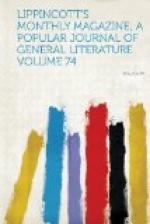The Gond also raises pumpkins and beans; and this vegetable diet he supplements with game ensnared in the dhyas, to which peafowl, partridges, hares and the like resort. Many of the villages, however, have a professional huntsman, who will display the most incredible patience in waiting with his matchlock for the game to appear.
Besides these articles of diet, the aborigines of the Gondwana have their mhowa tree, which stands them in much the same multifarious stead as the palm does to its beneficiaries. The flowers of the mhowa fall and are eaten, or are dried and pressed, being much like raisins: they also produce a wine by fermentation and the strong liquor of the hill-people by distillation. Of the seed cakes are made, and an oil is expressed from them which is an article of commerce.
In addition, the poor Gond appears to have a periodical godsend resulting from a singular habit of one of the great Indian plants. The bamboo is said to undergo a general seeding every thirty years: at this period, although, in the mean time, many individual bamboos may have passed through the process of reproduction, it is said that the whole bamboo growth of a section will simultaneously drop its leaves and put forth large panicles of flowers, after which come great quantities of seeds much like rice. These are gathered for food by the inhabitants with all the greater diligence in consequence of a tradition—which, however, does not seem to be at all supported by facts—that the general seeding of the bamboo portends a failure of the regular crops. The liberal forests of the Gondwana furnish still other edibles to their denizens. The ebony plums, the wild mango, the seeds of the sal tree, the beans of the giant banhinia creeper, a species of arrowroot, and a wild yam, are here found and eaten.




